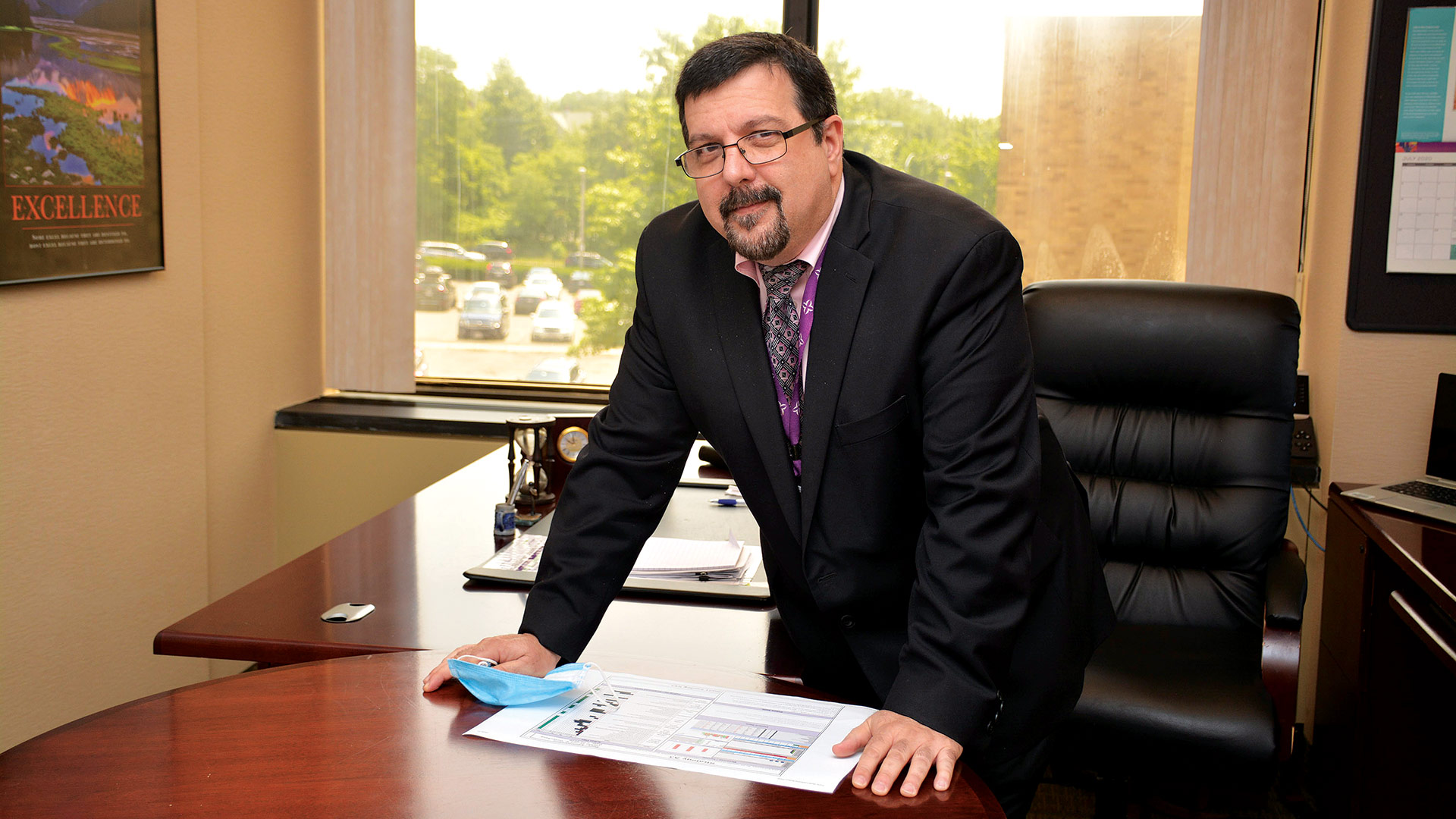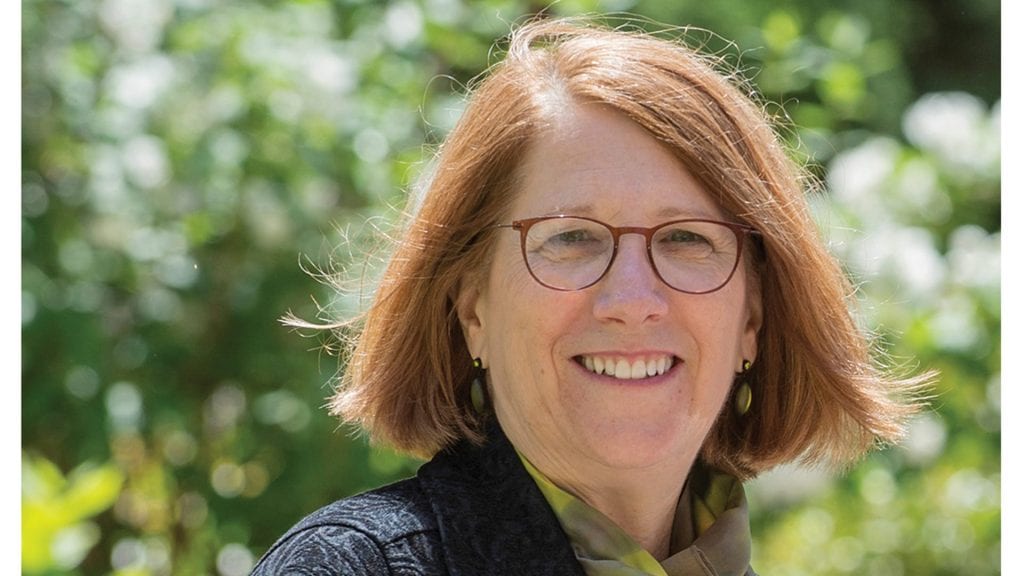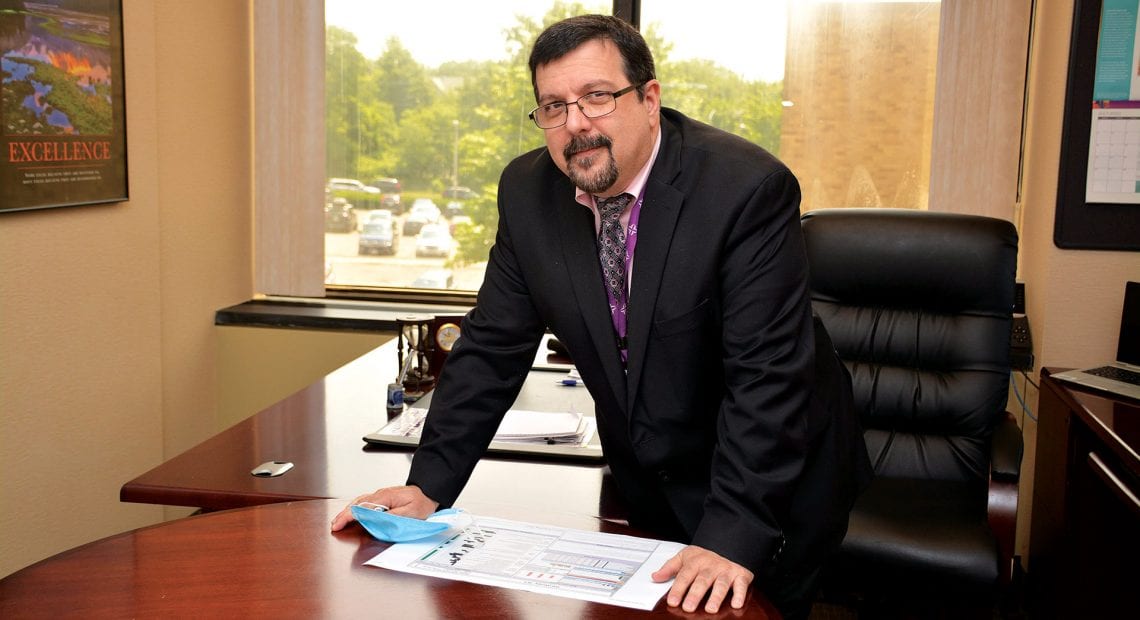Critical Condition

Guy DiStefano says the non-urgent procedures that were shut down in March typically support the rest of what hospitals do, leading to major revenue shortfalls this spring.
Back in March, when COVID-19 was just starting to crest, hospitals took steps to brace for a potential surge of patients. But while COVID-19 surged, revenues slowed to a trickle.
“Early on, we realized we needed to build capacity for a surge of patients so we didn’t get overwhelmed like they did in New York City, so we shut things down early in March — which blew a hole in everybody’s finances,” said Mark Keroack, president and CEO of Baystate Health. “We’ve been gradually returning to prior operations. We always remained open, of course, but it was only a week or two ago that we resumed more elective kinds of cases.”
Many hospitals are doing the same, but the overall losses to the state’s hospital industry are, as Keroack put it, “staggering” — expected to total between $5 billion and $6 billion by the end of the fiscal year on Sept. 30. “It’s a big stress test, if you will, for hospitals. And some have been hit more than others.”
All area hospitals have taken a financial blow.
“This has been very challenging, with the reduction in services,” said Guy DiStefano, vice president of Finance at Mercy Medical Center. “All our outpatient services — what are termed non-urgent cases, which usually help feed and support what a hospital does in its normal, day-to-day business — has been shorted, leaving us with a great revenue shortfall.”
At the same time, he added, “we still have all our expenses in place, just like any other business. Look at restaurants — the doors were closed, but they still had rent, utilities, all the other expenses, and the employees.”
Through May, Mercy saw a $25 million reduction in revenues due to pandemic-related reductions in services — and plummeting volume in the ER, a development that surprised hospital officials nationwide. At Mercy, daily Emergency Department cases dropped from a typical average of between 225 and 250 to around 100 to 120.
“Those slowly crept back up — we’re at 150 to 180 on a daily basis, so we’re not at full capacity, and there’s a lot of pent-up demand. Our business is coming back, but we lost a lot of revenues.”
“All our outpatient services — what are termed non-urgent cases, which usually help feed and support what a hospital does in its normal, day-to-day business — has been shorted, leaving us with a great revenue shortfall.”
Joanne Marqusee, president and CEO of Cooley Dickinson Hospital, said the hit has been significant. Through May, the facility recorded a loss of $18 million, partly due to COVID-related costs, but mostly because of lost volume. That number would be worse if not for $5.5 million in federal support.
“But that in no way covers our losses,” she added, noting that Cooley Dickinson Health Care could see a revenue shortfall of well above $30 million for the fiscal year ending on Sept. 30.
“We’re now planning for a fiscal-year 2021 budget and considering a number of measures to mitigate some of this — things like hiring freezes and reducing a lot of discretionary expenses. Everywhere we can hold off on spending, we have,” she went on, noting that service hours could be temporarily curtailed in some services, while employees making more than $26.50 per hour will forgo raises for the time being.
While that move shaves some costs while protecting lower-paid employees, it doesn’t make nearly enough of a dent, Marqusee noted. “So we’re looking at ways to further reduce expenses. But the work we’re doing already will certainly have an impact.”
DiStefano said Mercy has also had to take steps like furloughs and reducing hours to mitigate the losses. “We did everything we could to help employees keep their benefits in place. But employees are the number-one cost of a typical hospital — about 50% to 60% of the cost structure.”
Holyoke Medical Center has been losing roughly $6.5 million per month since services were curtailed back in March, President and CEO Spiros Hatiras said. But the community hospital did take some steps early on to gird against the damage.
“We were probably the first hospital in the area to furlough folks; we didn’t hold off because we saw it was absolutely important to be financially viable because we don’t have a parent company to spot us money,” he told BusinessWest, adding that many furloughed employees took advantage of the $600 federal boost in unemployment and wound up bringing in more than they did while working.

Joanne Marqusee says she hopes patient volume returns not because of the revenue issue, but because patients shouldn’t forgo necessary care.
“That helped reduce expenses significantly,” he added, noting that almost 170 of 250 furloughed employees were back at the start of July, with another 80 to 90 expecting to return at month’s end. “Then MassHealth stepped in and allocated $11.8 million over four months to cover some of the losses, and we got a one-time payment from the feds of about $3 million. Add it all up, and through May, our losses were roughly $3 million — not insignificant, but we were able to survive it.”
Dollars and Sense
Baystate is surviving, too, Keroack said, emphasizing the importance the health system has not only on its 12,000 employees, but on the region, where it has an annual economic impact of some $4.2 billion.
When the fiscal year ends on Sept. 30, he expects Baystate to have lost about $160 million in revenues due to volume losses, but the system was able to secure about $75 million in federal relief and another $23 million state aid.
“The rest of that will likely be covered by reserves,” he added, noting that Baystate is fortunate to have both reserve funds and a broad service model.
“The smaller hospitals that have cash-flow problems got hit very hard because they didn’t have much in the way of reserves, but the other group is bigger hospitals that are highly specialized, like Mass General, where their revenues really depend on that elective surgical volume. Hospitals that are jacks of all trades and have good size, like Baystate, were hit less hard. Not to say it was pleasant what we’ve been through.”
Calling a $160 million revenue loss a ‘less hard’ hit may speak in some ways to the financial clout of the healthcare industry as a whole; it’s certainly one of the Commonwealth’s key economic drivers. And as patient volume continues to ramp back up, hospitals will be on safer ground when it comes to budgeting.
“At Baystate Medical Center, we’re at 80% to 90% capacity, so I would say people are mostly back.” Keroack said, noting that, while patients are returning gradually for routine care and procedures, current volume is still affected by social-distancing and sanitization measures that have slowed the pace of treatment. “In the community hospitals, they’re a bit further behind — more like 60% of former volume.
“In the long run, the question is, will volumes be permanently depressed?” he went on. “We’ve tried to convince people you really don’t want to put off stuff you know is worthwhile — you don’t want to ignore symptoms that might be serious. We have seen a number of people lately whose illness is much more serious than it would have been in pre-COVID days.”
Cooley Dickinson Hospital’s Emergency Department has seen a 100% increase from its COVID lows, during the height of the pandemic locally, when it was handling 35 to 45 patients per day. Now, ED providers are seeing 70 to 80 patients per day, which is still about 20% below the organization’s typical ED volume.
“We are seeing people with chronic illness who have waited too long to seek medical attention and are sick,” Emergency Department Nurse Director Sara McKeown said. “We have also seen an uptick in people seeking mental healthcare; patients presenting with substance-use issues and trauma are also increasing.”
Patient volume is bouncing back at Holyoke Medical Center and its community-based practices, but ED visits still lag, Hatiras said. “Anecdotally, we’ve heard of people putting off heart conditions and other things, and that can lead to bad outcomes. People shouldn’t stay home with serious conditions.”
That said, “I don’t blame the government for being overly cautious with closing down elective surgeries,” he added, noting that the elimination of many procedures over the past two months was, more than anything else, about preserving beds to treat an unpredictable pandemic.
“We’re now planning for a fiscal-year 2021 budget and considering a number of measures to mitigate some of this — things like hiring freezes and reducing a lot of discretionary expenses. Everywhere we can hold off on spending, we have.”
Now that the infection rate is being effectively controlled, he explained, hospitals are trying to communicate the message that they are safe places to visit — with plenty of strict protocols in place, from masking to social distancing to constant sanitizing — for patients who need to be seen.
DiStefano said the challenge has been ramping services back up — and bringing back furloughed workers — to match what is proving to be pent-up demand, but in a measured way. “It’s a delicate balance — how do we do this to best serve the community?”
It’s a long road back from the volume lows of the spring, when physician revenue dropped by 50. They’re now back around 65%, and inpatient beds are at about 80% of capacity. But people with serious health concerns should not put off care, he stressed, especially since the hospital has been diligent about infection protocols and keeping COVID-suspected patients separated from the rest.
“We take great pains to keep this environment safe,” he said. “The message to the community is, ‘if you are hurt, if you have a condition, this is a safe place to come.’” It helps, he added, to be affiliated with a larger system, Trinity Health, and while Mercy has rarely seen the kind of financial deficit it faced this spring, its leaders are still doing what they can to meet community health needs.
“We are the fabric of the community; there are no concerns about Mercy’s future,” DiStefano told BusinessWest. “We are going to be here for many years to come. Fortunately, we have the backing of a larger organization, and that helps a lot.”
Distance Learning
If there is an upside to navigating the pandemic, he said it might be the growing importance of telehealth, which became not just a convenient tool for providers and patients over the past few months, but a critical one — and one that seems to be on track to be covered by insurance payers in the future much more consistently than before.
“This has become more of a platform that allows us to reach out to patients,” said DiStefano, whose background in telemedicine goes back to the 1990s. “I hope it’s a bigger part of healthcare going forward. Obviously, you have to do some testing in the office, but you can do preliminary or follow-up appointments with telehealth, and that reduces the volume of patients in the waiting room and the physical office, which allows us to have a much cleaner, COVID-free environment to keep those people safe.”
In short, it’s a way to boost volume — and revenues — while making patients who do go to the hospital feel more secure.
Hatiras agreed. “We had to switch on the fly to do more telehealth, but what we saw was care being delivered even more efficiently,” he said. “We saw no-show rates completely drop. So it’s an effective way to provide care, and there will certainly be more pressure on insurers to reimburse appropriately for telehealth.”
Indeed, Marqusee added, “what has been stopping us from doing more telehealth has been reimbursement; I hope we never go back to the days when we were so underpaid for telehealth. It has been a terrific model.”
In the meantime, she sees volume slowly returning to Cooley Dickinson — perhaps reaching 90% of a typical season come October. “But the reason we welcome those numbers is because people need to get care — it’s not because we need the volume. We know from national studies and anecdotally that people have been afraid, and they’re forgoing care, and that can really have health impacts for people.”
That’s why her facility, like the others BusinessWest spoke with, is not only maintaining strict protocols around infection control, but is communicating what it’s doing with the community.
“People have to believe that and feel confident. It’s really important that people don’t stay home in pain with issues that will just get worse. People aren’t coming with heart attacks, or appendicitis, or they power through a head injury, and it turns out they had a brain bleed. People need to come for care, and they should know this is a place they can come and feel comfortable.”
Not so comfortable, however, that they neglect the behaviors that have reduced infection rates in Western Mass. and allowed hospitals to increase their non-COVID-19 services.
“We’re in a good place; there isn’t a high level of COVID in our community. But that can change quickly,” Marqusee said. “I want people to always remember the reason we have low levels of COVID is because of the efforts everyone is making to social distance, wear masks, and practice hand hygiene. We shouldn’t take the reopening as a sign they we don’t need to do those things, but to do it even more. That allows us to provide needed care to all our communities.”
Keroack says he expects some patients to enthusiastically return to care providers, while others will be stragglers who need more convincing — while others will continue to embrace telehealth as the best option.
“We may not return to our former volumes until we have a vaccine and everyone feels totally comfortable,” he told BusinessWest. “I think it’s going to be a process.”
Joseph Bednar can be reached at [email protected]






